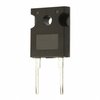-
A good PCB layout for optimal thermal performance involves placing the device near a thermal pad or a heat sink, using thermal vias to dissipate heat, and keeping the surrounding area clear of other components.
-
To ensure reliable operation at high temperatures, ensure that the device is operated within the recommended temperature range, use a suitable heat sink, and implement thermal monitoring and protection mechanisms.
-
Key considerations for EMI filtering and shielding include using a common-mode choke, adding capacitors to filter out high-frequency noise, and shielding the device and surrounding components to prevent electromagnetic interference.
-
When selecting input and output capacitors, consider the voltage rating, capacitance value, and equivalent series resistance (ESR) to ensure that they can handle the required ripple current and voltage.
-
The recommended settings for soft-start and overcurrent protection features depend on the specific application requirements, but generally involve setting the soft-start time to minimize inrush current and the overcurrent threshold to prevent damage to the device.
 STTH6010W datasheet
by STMicroelectronics
STTH6010W datasheet
by STMicroelectronics
Findchips
 STTH6010W datasheet
by STMicroelectronics
STTH6010W datasheet
by STMicroelectronics
 Findchips
Findchips